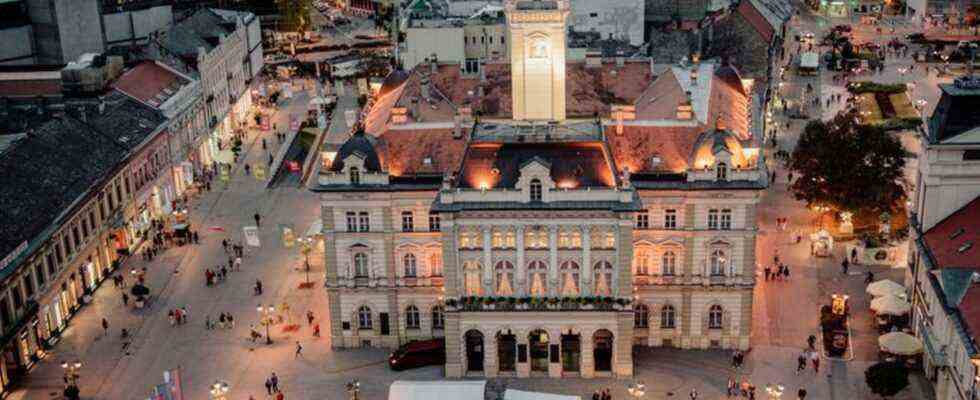Serbia
Cultural capital Novi Sad: the city of bridges
The northern Serbian city of Novi Sad is the cultural capital of 2022. Photo: Jelena Ivanovic / Foundation Novi Sad 2021 / dpa
© dpa-infocom GmbH
Novi Sad on the Danube lies at the interface between Central and Southeastern Europe. The Capital of Culture year offers the Serbian city the chance to show its diversity and creativity. Will the program makers use them?
It is very busy in the house at Freiheitsplatz 3 in the center of the northern Serbian city of Novi Sad. In the office of the “Novi Sad 2021” foundation, young people concentrate on laptops and computers.
The furniture is functional and stylish at the same time, as one would imagine the space of a trendy start-up somewhere in Europe. There are only a few weeks until Serbia’s second largest city, Novi Sad, becomes European Capital of Culture – as a result of the corona pandemic, one year later, i.e. 2022 instead of 2021.
Nemanja Milenkovic, the President of the Foundation, receives in the conference room. The 44-year-old program maker quickly gets to the point: “The message is: For new bridges! It is an appeal to act, but also a vision. “
City with 340,000 inhabitants
Novi Sad is located on the middle course of the Danube, the great European river. It is the capital of the Vojvodina province, where, besides Serbs, more than a dozen other nationalities live. In 1748 the Austrian Empress Maria Theresa granted the settlement, which is called Neoplanta in Latin, the title of a free royal city. From now on, they should name their citizens in their respective mother tongue: Neusatz in German, Ujvidek in Hungarian and Novi Sad in Serbian.
Until 1918, the city was part of the Austro-Hungarian monarchy, which still shapes it today. Three bridges span the Danube. They were destroyed in the NATO bombing in spring 1999 when the western alliance forced the Serbian warlord at the time, Slobodan Milosevic, to give up Kosovo, which was populated by Albanians. The bridges, which have since been rebuilt, also represent what connects them, emphasizes Milenkovic.
With a budget of 60 million euros, the city with 340,000 inhabitants is putting an ambitious program off the ground. Topics such as migration, women in art and the future of Europe are dealt with. “By the end of 2022 we will have 5,000 European artists with us,” says Milenkovic, not without pride.
For the opening on January 13th – the date coincides with the Orthodox New Year – the Slovenian avant-garde artist Dragan Zivadinov is creating an open-air spectacle entitled «Zeniteum». The title alludes to the style-defining Yugoslav avant-garde art magazine “Zenit”, which was first published in Zagreb and then in Belgrade in the 1920s. The Franco-German poet Yvan Goll (1891-1950) was also in close contact with the “Zenitists”, who are widely networked around the world.
The corona pandemic does not seem to upset the makers of the Capital of Culture. “It’s a big challenge, but we’ve gained experience,” says Milenkovic, one of the co-founders of the Exit music festival. Serbia actually only had one tough lockdown, in spring 2020, and then rather mild measures. Since then there have been many preliminary programs for the Capital of Culture year in Novi Sad.
Stricter measures do not seem to be ruled out at the moment. Shortly before Christmas, the Omikron variant was detected for the first time in Serbia among travelers returning from Africa.
The free cultural scene is skeptical
Critics of the Capital of Culture program complain that the makers rely on appearance instead of sustainability, on effect instead of depth. The foundation president may be an excellent PR expert, but he has no competent artistic director at his side, it is said. Large parts of the independent art scene in Novi Sad did not warm to the European Capital of Culture project.
“We discussed with them for four years. In vain, ”says Zoran Pantelic, who runs the multi-media center“ Kuda.org ”on the outskirts of the city. “They are more interested in culture than presentation and not so much in culture as production.”
Milenkovic does not want to let the accusation sit on him. Abandoned factories and warehouses have been prepared and made operationally safe. “We make all of this available to culture.” The doors are open to the independent scene. It remains to be seen whether the different understandings of culture can find each other.

